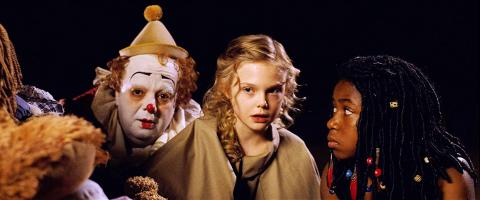The first thing that must be said about Andrei Konchalovsky’s The Nutcracker in 3D is that if you are looking to recapture the magic of Tchaikovsky’s much-loved ballet, or even be taken into the fantastical world of ETA Hoffmann’s story The Nutcracker and the Mouse King, on which the ballet was based, prepare to be disappointed. Konchalovsky has taken a hatchet to both the book and the music, and what emerges is not a deconstruction of the fairy tale, but a thorough massacre of it.
In and of itself, there is no reason why taking a well-loved fairy tale apart and reconstituting it in new ways should be a bad thing. Post-modernism is in our blood, and little of the past is safe from our tinkering. After all, conventional productions of Tchaikovsky’s ballet, for all the beauty of the music, have become just a tad shopworn through familiarity. Moreover, it has become common knowledge that fairy tales, such as those collected by the Brothers Grimm and Hans Christian Andersen, were a lot less innocent than the tidied up versions that grace children’s playrooms.
Unfortunately, Konchalovsky has chopped up Tchaikovsky’s music into little snippets and tied them to doggerel verse composed by Tim Rice in what he appears to think is a cleverly ironic fashion. The Nutcracker in 3D never becomes a full-blown musical, but teeters hesitantly on the edge, with a few half-hearted musical numbers. And as for the darkness of fairy tales, Konchalovsky has simply dumped an ungainly heap of Holocaust imagery into the film and turned the mouse king into a fascist dictator. This would be merely ridiculous if it weren’t in such bad taste.

Photo courtesy of Applause Entertainment
The story opens in 1920s Vienna. Mary (Elle Fanning) receives a special Christmas present from her godfather: a wooden nutcracker in the shape of a red-coated soldier. This is in fact a young prince who has been turned into wood by the mouse queen, and whose kingdom has been conquered by an army of rats. These odious rulers take the toys from all the children in the city and burn them, creating a black fog around the city. While not violent, scenes in which dolls and teddy bears are torn from the arms of weeping children who are ineffectually pacified by terrified parents render this movie quite unsuitable for younger children.
Mary brings the nutcracker to life and helps the young prince battle the evil mouse queen. It goes without saying that they are ultimately victorious, aided by a motley crew of dolls that includes a fat clown, a black drummer boy and a cigar-smoking monkey, who are never adequately explained and don’t seem to serve any important function.
That Mary has entered into a dream is underlined by references to Freud, and the reason that Mary’s Uncle Albert is Einstein (E=MC2 even makes it into a song) is another baffling aspect of the film. The 12-year-old Elle Fanning does some of the best acting, putting the likes of Nathan Lane (Uncle Albert, whose Viennese accent is just a crude caricature), John Turturro (the Rat King) and Richard E. Grant (Mary’s father) to shame. Konchalovsky shows a slightly worrying tendency to sexualize Fanning — there are some unnecessary scenes when Mary’s conservative frock comes off the shoulder a little too conveniently — but this is all part and parcel of his uncertainty about whether he is making an edgy children’s film or exploring his own less than edifying neuroses.
Reportedly The Nutcracker in 3D was a dream project that the director has cherished hopes of making for 20 years, and the only evidence that might be presented in mitigation of this car crash of a film is that the poor man simply has had too long to think about the project and in trying to cram in too much has got everything into a muddle.
A final weakness is the “in 3D” so prominently displayed in the title. The film was not made for 3D, and was arguably only converted to this overrated format in an attempt to help sell tickets. This is just one more wrong decision, for 3D conversion is notorious for making a film darker and for reducing contrast, and this has effectively stripped away whatever visual appeal the film may have originally had.

One of the most important gripes that Taiwanese have about the Democratic Progressive Party (DPP) is that it has failed to deliver concretely on higher wages, housing prices and other bread-and-butter issues. The parallel complaint is that the DPP cares only about glamor issues, such as removing markers of Chinese Nationalist Party (KMT) colonialism by renaming them, or what the KMT codes as “de-Sinification.” Once again, as a critical election looms, the DPP is presenting evidence for that charge. The KMT was quick to jump on the recent proposal of the Ministry of the Interior (MOI) to rename roads that symbolize

On the evening of June 1, Control Yuan Secretary-General Lee Chun-yi (李俊俋) apologized and resigned in disgrace. His crime was instructing his driver to use a Control Yuan vehicle to transport his dog to a pet grooming salon. The Control Yuan is the government branch that investigates, audits and impeaches government officials for, among other things, misuse of government funds, so his misuse of a government vehicle was highly inappropriate. If this story were told to anyone living in the golden era of swaggering gangsters, flashy nouveau riche businessmen, and corrupt “black gold” politics of the 1980s and 1990s, they would have laughed.

It was just before 6am on a sunny November morning and I could hardly contain my excitement as I arrived at the wharf where I would catch the boat to one of Penghu’s most difficult-to-access islands, a trip that had been on my list for nearly a decade. Little did I know, my dream would soon be crushed. Unsure about which boat was heading to Huayu (花嶼), I found someone who appeared to be a local and asked if this was the right place to wait. “Oh, the boat to Huayu’s been canceled today,” she told me. I couldn’t believe my ears. Surely,

When Lisa, 20, laces into her ultra-high heels for her shift at a strip club in Ukraine’s Kharkiv, she knows that aside from dancing, she will have to comfort traumatized soldiers. Since Russia’s 2022 invasion, exhausted troops are the main clientele of the Flash Dancers club in the center of the northeastern city, just 20 kilometers from Russian forces. For some customers, it provides an “escape” from the war, said Valerya Zavatska — a 25-year-old law graduate who runs the club with her mother, an ex-dancer. But many are not there just for the show. They “want to talk about what hurts,” she